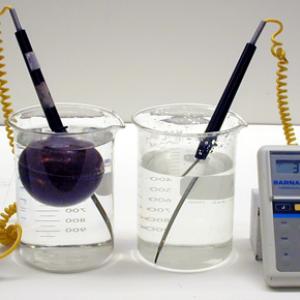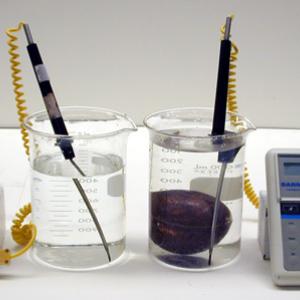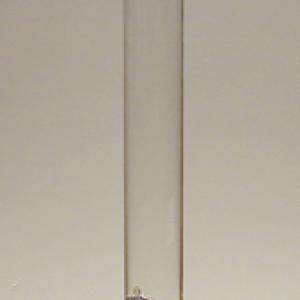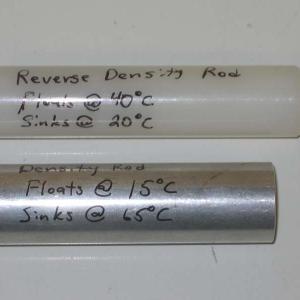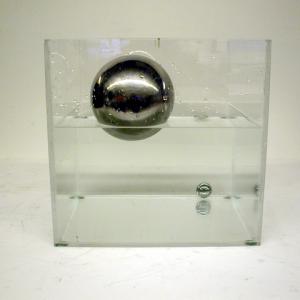College of Liberal Arts & Sciences
2B40.59 - Density Ball, Rods, Galilean Thermometer, Eggs
Take cold water directly from tap (about 22º C), and place in one beaker. Place warm water (about 35º C), in the other beaker. Insert the thermometer probes to monitor the temperatures. When you place the density ball into the cold water it should just barely float. When placed in the hot water the density ball should sink.
The density rod is designed to show the same effect as the density ball described above. That is it will float in cold water but sink in hot.
The reverse density rod will show the opposite effect. That is it will sink in cold water and float in hot.
Another example of this would be the two balls that have equal masses yet one floats and one does not due to different volumes.
- Martin Gardner, "Two Stunts with Eggs", TPT, Vol. 37, #4, Apr. 1999, p. 245.
- Dick Heckathorn, "A Density Demonstration", TPT, Vol. 25, #1, Jan. 1987, p. 39.
- Linda L. Maier, "Eggs—Sink or Float", The Science Teacher, Vol. 56, #4, Apr. 1989, p. 68.
- "F-135. Plastic Ball in Salt Solution", DICK and RAE Physics Demo Notebook, 1993.
- Rick Beyer, "Bath Time", The Greatest Science Stories Never Told, p. 2.
- Joey Green, "Floating Egg", The Mad Scientist Handbook 2, p. 37.
- H. J. Press, "133. Suspending an Egg", Giant Book of Science Experiments, p. 144.
- Janice VanCleave, "87.On Top", Janice VanCleave's 204 Sticky, Gloppy, Wacky, and Wonderful Experiments.
Disclaimer: These demonstrations are provided only for illustrative use by persons affiliated with The University of Iowa and only under the direction of a trained instructor or physicist. The University of Iowa is not responsible for demonstrations performed by those using their own equipment or who choose to use this reference material for their own purpose. The demonstrations included here are within the public domain and can be found in materials contained in libraries, bookstores, and through electronic sources. Performing all or any portion of any of these demonstrations, with or without revisions not depicted here entails inherent risks. These risks include, without limitation, bodily injury (and possibly death), including risks to health that may be temporary or permanent and that may exacerbate a pre-existing medical condition; and property loss or damage. Anyone performing any part of these demonstrations, even with revisions, knowingly and voluntarily assumes all risks associated with them.
